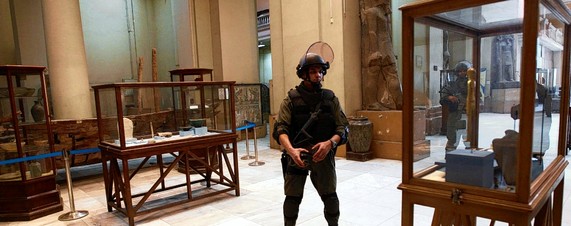A definitive answer to the question: Should the Elgin Marbles be returned to Greece?
click on the photo for full view
Alex Joffe
The Wall Street Journal
2/1/2011
When Zahi Hawass, the secretary general of the Supreme Council of Antiquities, came to work at the Egyptian Museum on Saturday, he found that looters had broken in and beheaded two mummies—possibly Tutankhamun’s grandparents—and looted the ticket booth. Reports indicate that middle-class Egyptians, the tourism police and later the military secured the museum. But now it appears that many other museum’s and storehouses have been looted, along with archaeological sites. A vast, impoverished underclass seems less taken with either the nationalist narrative of Egyptian greatness that stretches back to the pharaohs, or the intrinsic value of antiquities for all humanity, and more intrigued by the possibility of gold and other loot. For his part, Mr. Hawass has now been appointed state minister for antiquities by President Hosni Mubarak.

The bust of Nefertiti at Berlin's Neues Museum, one of the many artifacts around the world that Egypt has requested be returned./Photo AP/click for full view
These events make Mr. Hawass’s quest to return all Egyptian objects to Egypt misguided or at least poorly timed. Last week he again demanded the return of the bust of Nefertiti from Berlin. The Rosetta Stone in the British Museum has long been on Mr. Hawass’s wish list, along with the Zodiac Ceiling in the Louvre and statues in Boston’s Museum of Fine Arts and museums in Hildesheim, Germany, and Turin, Italy. And a few weeks back he complained bitterly that the obelisk known as Cleopatra’s Needle, a gift to the U.S. from the Khedive of Egypt that has graced Central Park since 1881, was in poor condition and might have to be reclaimed. He has made similar demands for the repatriation of Egyptian artifacts around the world, whether purchased, donated or stolen. But can Egypt even look after what it has? This question is now out in the open…
…In the past Egypt also experienced outbursts of Islamic radicalism that claimed artifacts and monuments. Napoleon usually gets the blame for destroying the nose of the Great Sphinx at Giza, but historical sources blame the 14th-century iconoclast Muhammad Sa’im al-Dahr. The outer casing stones of the pyramids at Giza were carried off, also in the 14th century, by the Sultan An-Nasir Nasir-ad-Din al-Hasan to build the mosques of Cairo. But today Egypt’s past is one of the country’s most important sources of income. Some 14 million tourists visited Egypt in 2010. Still, in the modern era the Egyptian Muslim Brotherhood has made it clear that it wants to Islamify all aspects of Egyptian life. This will inevitably reach into the Egyptian treatment of the past…
Read the complete article at The Wall Street Journal.
Related: Afghan Taliban leader orders destruction of ancient statues, from February 2001. The 10th anniversary of the destruction of the Buddhas was marked in Paris this week.
Update: Hawass quits, warns of antiquity looting, at The Astute Bloggers.








